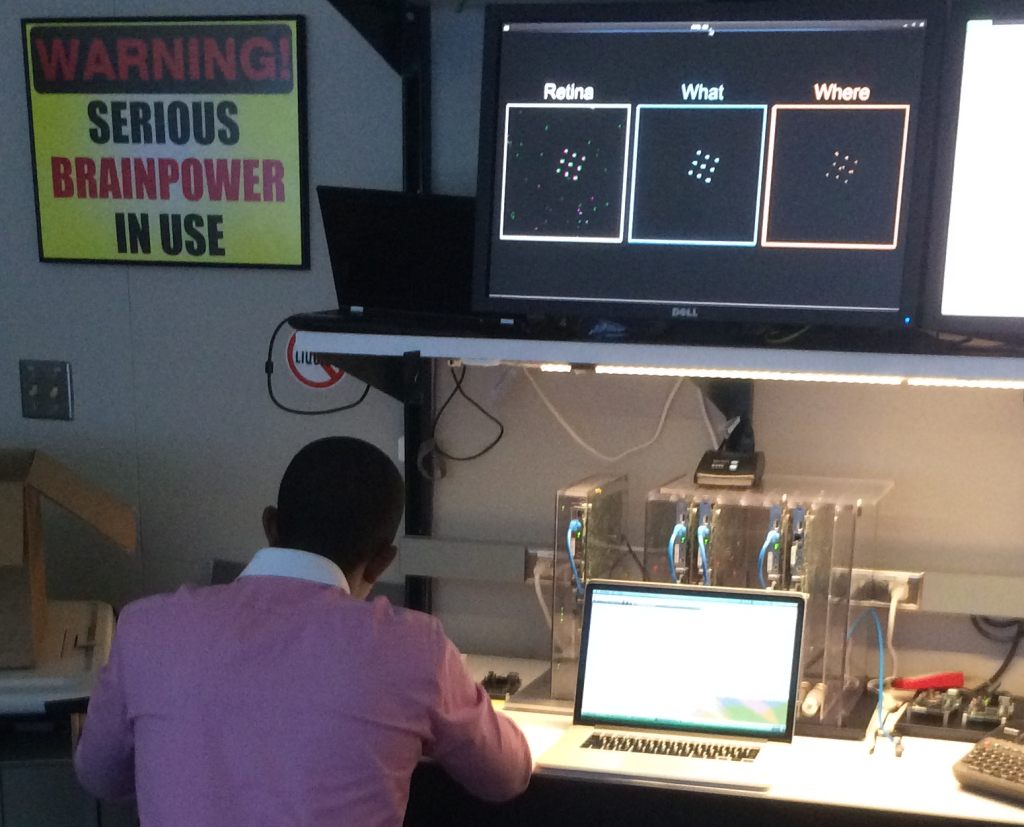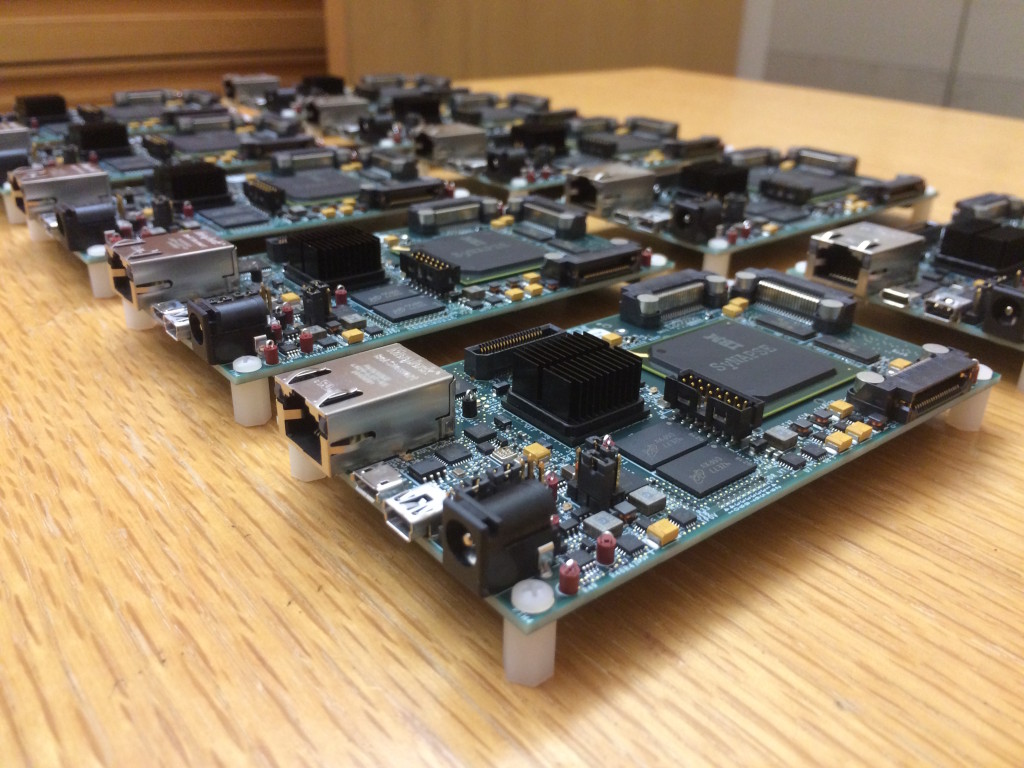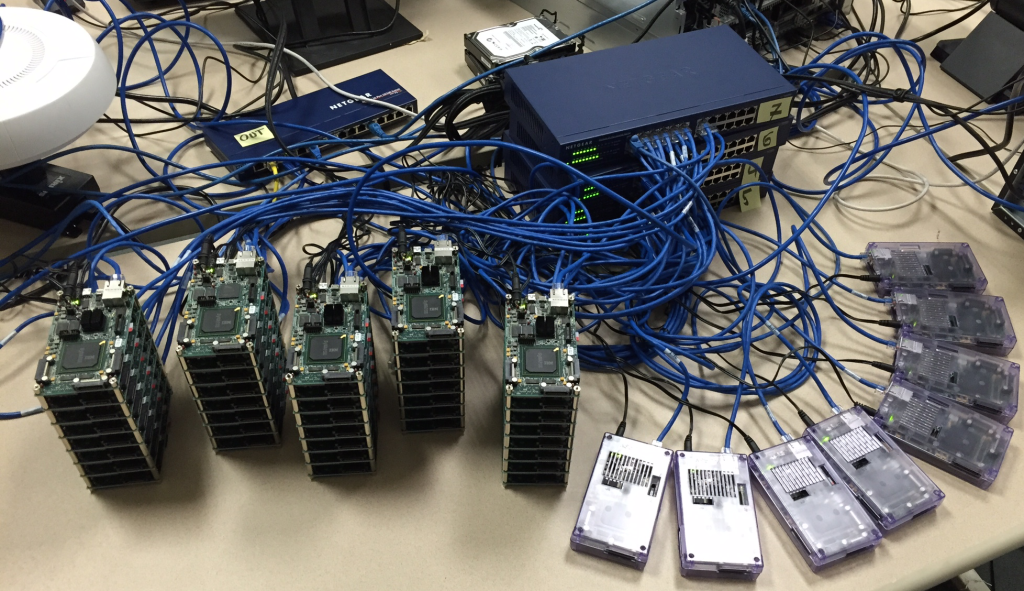The group I belong to, IBM Cognitive Computing, was featured in Wired. You can view the article here: IBMs Rodent Brain Chip Make Phones Hyper Smart
Tag: brain-inspired-computing
Boot Camp Prep – Behind the Scene: Hardware Edition
Today, we end our first week of a 3-week TrueNorth bootcamp, where we began to unveil and teach the ecosystem for TrueNorth. We take a look behind the scenes and present some of the effort the team has put forth when preparing the hardware for participants to learn on, play with, and eventually call their own.
The goal was simple: Assemble, test, and configure the first batch of 100 single-chip, index card-sized TrueNorth development boards (dubbed NS1e for Neurosynaptic System Evaluation Platform), 48 of which will be used as the playground for the Boot Camp participants. First to learn on, but eventually to take home and continue to develop their own algorithms and apply to their own applications. While seemingly straightforward, several items had to come together to allow us to provide users with an experience that has become expected of a development platform. While there was much to do, boards from the factory were received almost exactly one month to the day (actually less), leaving very little room for errors. Here is a timeline that summarizes our experiences as we worked to deliver the hardware in time for bootcamp:
07/01/15-07/06/15: NS1e boards are in-route from the factory, but there is little time to waste. We begin to create manufacturing and test scripts responsible for exercising board components as well as tracking boards as they execute the test procedures.
07/08/15: Boards are here! Less than one month away from bootcamp, we received NS1e boards in Almaden for assembly, test, and staging.
07/09/15: It was all hands on deck as we began to assemble and test the boards, attaching feet and heat sinks, everyone got involved in the fun! After boards were assembled, they were run through a round of testing which exercised TrueNorth and other discrete components to ensure functionality.

7/9/15: Due to the hardwork of the team and lab members, all boards were tested and configured by the end of the day!

07/10/15-07/24/15: With two weeks before we begin infrastructure testing the team still needed to decide how the NS1e boards would be finally configured. One important choice was which operating system would be loaded on the embedded Zynq platform: whether to use the strongly tested Petalinux or to push to provide Ubuntu. The team collectively decided to ensure the boards could run Ubuntu, which enables the NS1e platforms to pick up applications from the Linux community at large and expands the platforms versatility. To enable this, the team worked to resolve a few compatibility issues, but finally managed to get a working and tested image in time for infrastructure testing.
07/24/15-7/30/15: Infrastructure testing week! Due to the number of participants we split our 48 boards across 4 gateway servers. Testing now consists of ensuring each board is accessible by the servers and each has the latest version of the image containing FPGA firmware, OS, and the TrueNorth control software. S ome load testing is also performed to see what happens when many users are requesting to use boards simultaneously. Things mostly worked, and we fixed what didn’t.

07/31/2015: It is the weekend before bootcamp, so the team builds the final home of the NS1e development boards before they are finally transported to the classroom. Each of the NS1e platforms are placed into individual cases and inserted into a 6×8 array. The final rack contains the same number of neurons as a small mouse (48 Million Neurons and 12 Billion Synapses)! Now off to bootcamp!
This blog previously appeared on modha.org
What’s Wrong with Convolution Neural Nets?
Interesting talk on how to rethink convolutional nets for feature extraction and classification. What’s wrong with convolutinal nets
I’ve Joined the Cognitive Computing group at IBM Research
As of March, I will be joining the Cognitive Computing Group at IBM Research, Almaden
This is certainly an exciting opportunity, especially considering where the computing industry is today with slowing technology scaling, increasing power densities, and higher importance being placed on analyzing disparate data-sets made up of ever-increasing size.
This seems to be the right time for a paradigm shift in computing to take place. While tradition computing has served us very well, and will continue to do so in the future for a variety of domains, sensor technologies and data collection methods have been improving at an exponential rate, while simultaneously becoming more pervasive in our every day lives. Although techniques which are able to analyze all of this new data exist, for many applications, none have been able to rival the power of the brain in terms of efficiency or computation capability. Today, we may have only scratched the surface of realizing what this data may be able to tell us using traditional models. Having a “programmable brain” at our fingertips may lead to many unforeseen discoveries and insights of the world around us. I am excited to be a part of it.
More information on the group and project can be found here:
IBM Research: Neurosynaptic Chip
Brain-inspired Computing: A Decade Long Journey (Dharmendra Modha, video)
IBM Colloquium: The Future of Cognitive Computing
Introducing a Brain-inspired Computer
Dharmendra Modha’s Cognitive Computing Blog
Brain-Inspired Computing
Last week I attended two events,
NSF review and workshop at Penn State to discuss progress within the NSF Expeditions in Computing Program, Visual Cortex on Silicon. Speakers included:
- Vijaykrishnan Narayanan (Penn State)
- Steve Levitan (UPitt)
- Laurent Itti (USC)
- Jack Carol (Penn State)
- Dan Kifer (Penn State)
IBM’s Cognitive Computing Colloquium at IBM Research, Almaden hosted by IBM Fellow and Chief Scientist of Brain-Inspired Computing, Dharmendra Modha. The event covered a wide variety of topics from neuroscience, computing, and included an in-depth set of talks about the TrueNorth Architecture, Programming Model, Simulators, and Platforms. Speakers included:
- Andreas Andreou, Johns Hopkins
- Dharmendra S Modha, IBM Fellow, IBM Chief Scientist, Brain-Inspired Computing
- Fei-Fei Li, Director, AI Lab, Stanford University
- Gary Marcus, NYU
- Gill Pratt, DARPA SyNAPSE Program Manager
- Horst Simon, Deputy Director, Lawrence Berkeley National Lab
- Karlheinz Meier, Co-Director, Human Brain Project, U. Heidelberg
- Mark Anderson, Future in Review and Strategic News Service
- Michael Hawrylycz, Allen Institute for Brain Science
- Miyoung Chun, Executive VP of Science Programs, Kavli Foundation
- Rajit Manohar, Cornell University, Associate Dean
- Richard Cytowic, Author of Synesthesia: A Union of the Senses
- Jayashree Subrahmonia, Vice President, Products, IBM Watson Group
- Tobi Delbruck, Co-Founder, iniLabs & Professor, ETH
- Vijaykrishnan Narayanan, PI, NSF Expeditions in Computing, Professor, Penn State